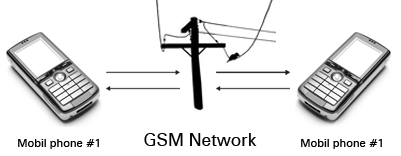GSM phone lines
GSM stands for Global System for Mobile Communications. It is the most popular and known standard that is used for mobile phone systems all over the world. In case of GSM systems signaling and speech channels are digital, therefore it is regarded as a second generation mobile system. GSM also makes it possible to implement data communication applications into the system. GSM also supports short message services (SMS).
Technical details
GSM is a cellular network meaning that cell phones can connect to it by searching for cells near to the given phone. Five cell sizes can be differentiated in regard to GSM network: macro, micro, pico, femto and umbrella cells. The coverage area of the cells depends on the implementation environment in this way they can be various (Figure 1).

Macro cells: in this case the base station antenna is installed on a mast or a building above average roof top level.
Micro cells: their antenna height is under average roof top level, mainly used in urban areas.
Picocells: they are small cells with a few dozen meters coverage diameter, mainly used indoors.
Femtocells: they are used in residential or small business environments and connect to the network of the service provider via a broadband internet connection.
Umbrella cells: cover shadowed regions of smaller cells and fill in gaps in coverage between those cells.
Modulation
In regard to GSM, the GMSK (Gaussian minimum-shift keying) modulation is used that is a continuous-phase frequency shift keying.
GSM carrier frequencies
GSM networks function in numbers of various carrier frequency ranges that are separated into GSM frequency and UMTS frequency ranges. Most 2G GSM networks operate in the 900 or 1800 MHz bands.
Voice codecs
GSM uses a range of voice codecs to compress 3.1 kHz audio into between 6.5 and 13 kbps. At first, there were two codecs that have been named after the types of data channel they were allocated Half Rate (6.5 kbps) and Full Rate (13 kbps). They used a system based upon LPC (linear predictive coding) and they allowed an easier identification of more important parts of the audio. The Enhanced Full Rate (EFR) codec is a further developed codec (12.2 kbps). It uses a full rate channel. AMR-Narrowband is the codec that ensures high quality and robust against interference when used on full rate channels while it is less robust but still quite high quality when applied in good radio conditions on half-rate channels.
Standards information
The GSM systems and services are specified in a set of standards governed by ETSI.
